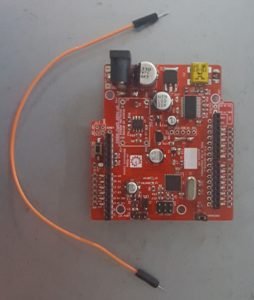VIDEO
DEMO VIDEO In this project we will create a simple oscilloscope, using only the gizDuino LIN.https://processing.org/download/ Arduino IDE.
Materials:
Upload the following code to your Arduino.
/* Poor's Man Oscilloscope Arduino Skecth This is an example code for reading the analog input and to display the value signal output on processing. */ #define ANALOG_IN 0 void setup () { Serial.begin (9600 ); } void loop () { int val = analogRead (ANALOG_IN); Serial.write ( 0xff ); Serial.write ( (val >> 8 ) & 0xff ); Serial.write ( val & 0xff ); }
and Run this following code to the Processing IDE.
/* * Oscilloscope * Gives a visual rendering of analog pin 0 in realtime. * * This project is part of Accrochages * See http://accrochages.drone.ws * * (c) 2008 Sofian Audry (info@sofianaudry.com) * * This program is free software: you can redistribute it and/or modify * it under the terms of the GNU General Public License as published by * the Free Software Foundation, either version 3 of the License, or * (at your option) any later version. * * This program is distributed in the hope that it will be useful, * but WITHOUT ANY WARRANTY; without even the implied warranty of * MERCHANTABILITY or FITNESS FOR A PARTICULAR PURPOSE. See the * GNU General Public License for more details. * * You should have received a copy of the GNU General Public License * along with this program. If not, see <http://www.gnu.org/licenses/>. */ import processing.serial.* ;Serial port; // Create object from Serial classint val; // Data received from the serial portint [] values;float zoom;void setup (){ size (1280 , 480 ); // Open the port that the board is connected to and use the same speed (9600 bps) port = new Serial (this , Serial . list()[0 ], 9600 ); values = new int [width ]; zoom = 1.0f ; smooth (); } int getY (int val ) { return (int )(height - val / 1023.0f * (height - 1 )); } int getValue () { int value = - 1 ; while (port. available() >= 3 ) { if (port. read() == 0xff ) { value = (port. read() << 8 ) | (port. read()); } } return value; } void pushValue (int value ) { for (int i= 0 ; i< width - 1 ; i++ ) values[i] = values[i+ 1 ]; values[width - 1 ] = value; } void drawLines () { stroke (255 ); int displayWidth = (int ) (width / zoom); int k = values. length - displayWidth; int x0 = 0 ; int y0 = getY(values[k]); for (int i= 1 ; i< displayWidth; i++ ) { k++ ; int x1 = (int ) (i * (width - 1 ) / (displayWidth- 1 )); int y1 = getY(values[k]); line (x0, y0, x1, y1); x0 = x1; y0 = y1; } } void drawGrid () { stroke (255 , 0 , 0 ); line (0 , height / 2 , width , height / 2 ); } void keyReleased () { switch (key ) { case ' +' : zoom *= 2.0f ; println (zoom); if ( (int ) (width / zoom) <= 1 ) zoom /= 2.0f ; break ; case ' -' : zoom /= 2.0f ; if (zoom < 1.0f ) zoom *= 2.0f ; break ; } } void draw (){ background (0 ); drawGrid(); val = getValue(); if (val != - 1 ) { pushValue(val); } drawLines(); }
Documented by: Kayle Urbano
For more details about the projects, see the following reference: Electronics Projects, Tutorials and Reviews. (n.d.). Retrieved from https://randomnerdtutorials.com/

















-50x50w.jpg)




 by
by
18 Comment(s)
Is Technology Making Robot Vacuum Cleaner Uk Better Or Worse? Best Robot Vacuum Cleaners
The Reason You Shouldn\'t Think About Making Improvements To Your Robot Vacuum Cleaners robotic Floor cleaner
Cheap Robot Hoover Tools To Ease Your Daily Lifethe One Cheap Robot Hoover Trick Every Individual Should Learn Cheap Robot hoover
Why You\'re Failing At Auto Vacuum automatic floor vacuum
Guide To Automatic Hoovers: The Intermediate Guide For Automatic Hoovers automatic hoover (1v34.com)
See What Automatic Vacuum Cleaner Uk Tricks The Celebs Are Utilizing automatic vacuum cleaner uk [https://www.nunesmagician.com/users/tpmen99]
Robot Cleaner Vacuum And Mop Tools To Improve Your Daily Life Robot Cleaner Vacuum And Mop Trick Every Individual Should Be Able To robot Cleaner
See What Best Robotic Hoover Tricks The Celebs Are Using best robotic Hoover
9 Lessons Your Parents Teach You About Robotic Vacuum Cleaner Uk robotic vacuum cleaner uk
14 Smart Ways To Spend The Remaining Robotic Vacuum Budget Robot Vacuum Cleaner
The 10 Most Terrifying Things About Best Robotic Vacuum Cleaners best robotic vacuum cleaners
16 Must-Follow Facebook Pages For Robot Hoover Uk-Related Businesses Robotic Vacuum
9 Things Your Parents Taught You About Robotic Vacuum Cleaner Uk robotic vacuum cleaner uk
Robot Robotic Vacuum Cleaners Tools To Streamline Your Daily Lifethe One Robot Robotic Vacuum Cleaners Trick That Every Person Must Know robot robotic Vacuum cleaners
Are You Getting The Most Value From Your Robotic Hoover? robotic hoover and mop
10 Inspiring Images About Automatic Vacuum Cleaner robotic vacuum
Five Killer Quora Answers To Robot Vacuum Cleaner Uk Robot Vacuum Cleaner
The 10 Scariest Things About Robot Vacuums & Mops Robot Vacuums & Mops (Https://Opensourcebridge.Science/Wiki/Why_Nobody_Cares_About_Which_Robot_Vacuum_Cleaner)
Leave a Comment